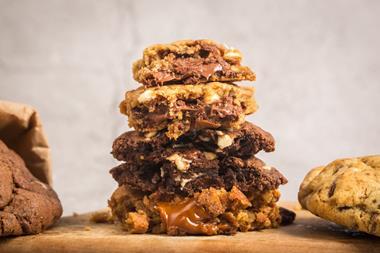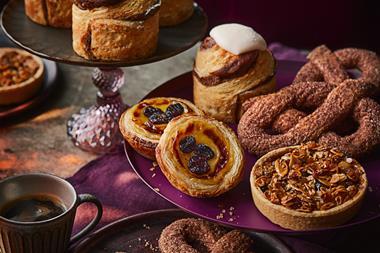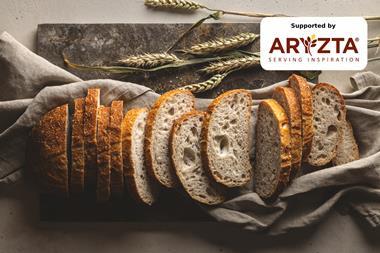UK consumers are no strangers to flatbread, with tortillas and naan featuring regularly on the menu. But some think it’s about time Brits expanded their culinary horizons…
Naan on the side of an Indian, fajitas and, of course, pizza – Brits are well accustomed to chowing down on a variety of flatbreads.
As such, it’d be easy to think the flatbread market is all wrapped up. But think again. There’s a whole world of inspiration just begging to be introduced to UK shoppers.
“While innovation is injecting more excitement into bread, and allowing it to leverage Britons’ love of foreign cuisine to a certain extent, more manufacturers should be looking further afield for international bread and baked goods,” says Emma Clifford, associate director, food and drink at global market research firm Mintel.
“With authenticity highly desirable within world cuisines in general, a stronger focus on this angle is needed to score points with today’s foodies.”
So, where in the world should bakers and manufacturers be looking for inspiration and what separates these breads from naan, pitta and the like?
With strong connections – and a production facility – in India, Signature Flatbreads is turning its attention to other offerings from the country. “We have chapati, roti and peshwari – a number of Indian breads that haven’t taken off in the UK as yet, whereas in India they are the norm,” says Tim Wittekind, head of innovation and NPD at the company. “They are waiting to take off in a bigger way.
“Also, we previously made filled Indian breads such as kulchas, but they were probably ahead of their time, so we may see those start to be introduced to the market.”
Wittekind believes each of the three main types of flatbread provide their own opportunities: filled bread, such as kulcha, can be eaten on its own; thinner breads, such as tortillas and chapatis, are used as carriers for other ingredients; and side of plate bread, such as naan.
“We’ve seen particular growth in Middle Eastern-inspired flatbreads and associated fillings, within both the retail and food-to-go markets,” says Sam Cook, AB Mauri’s marketing business partner. “We’re also witnessing notable growth in the food-to-go market across a variety of naans and chapatis. This has certainly become more apparent over the past 18 months or so.”
Naansters’ filled naans, part of the Jake and Nayn’s brand, is just one example of this. The range was revamped earlier this year so the products could be eaten hot or cold, with a vegetarian Chickpea Curry variant added to the existing range, which includes Beef Madras and Chicken Tikka.
As for carrier breads, retailers have expanded beyond beige tortillas, with bright purple, deep green and yellow ones hitting the shelves. These creations, such as The Co-op’s Beetroot & Feta wrap and M&S’ Turmeric Chicken Spinach Wrap with Spiced Sweet Potato and Cauliflower, offer customers a twist on familiar flatbreads, as well as a range of health benefits.
“The use of vegetable flours, such as pea, beetroot and even lentil, is on the increase,” says Kath Davies, NPD manager at food ingredients supplier EHL Ingredients, noting that many of these flours have the added benefit of being gluten-free. “They bring colour and enhanced visual appeal to finished products. Vibrant red, pink and green wraps, pittas, and flatbreads will certainly appeal to health-conscious consumers and the Instagram generation.”
Blue corn tortillas, from Funnybones Foodservice, hit the same spot. And Tom Styman-Heighton, Funnybones’ development chef, argues there’s still room for innovation, even with established items.
“Standard tortilla wraps have become as familiar as sliced bread sandwiches, but there are many types of tortilla wrap that we are yet to explore in this country,” he says. “Non-wheat wraps are common fare in South America, and the health benefits of corn-based wraps are beginning to be recognised in this country.”
Bakers don’t have to look as far as South America for inspiration, with Sweden, for example, providing food for thought closer to home. Flatbreads form a significant part of Swedish manufacturer Polarbröd’s range, offering rye-based products with a signature dimpled surface. In the UK, they are distributed frozen by Central Foods.
“These products are traditionally used as a base for an open sandwich. They are also used to make a smörgåstårta – a layered sandwich ‘cake’ – which is sliced into wedge-shaped portions, and served,” explains Central Foods MD Gordon Lauder. Traditional Swedish fillings include layers of prawns, hard boiled eggs, ham, cucumber, smoked salmon and lots of mayonnaise, and many of these would go down equally well in the UK, argues Lauder.
While a cake-style sandwich may take Brits some getting used to, topping flatbreads in a similar fashion to pizza is already taking off. In May, The Lebanese Bakery opened in London’s Covent Garden, serving traditional topped flatbreads from Manousheh, which are sprinkled with herbs, cheese, tomatoes and meat.
Meanwhile, Lagona Bakery, another Lebanese outlet, opened in Cambridge in April, suggesting demand for Middle Eastern food is gaining pace in the UK.
Looking even further ahead, Signature Flatbreads’ Wittekind predicts sweet flatbreads will start gaining traction.
“We’ll start to see sweet breads and the brioche equivalent coming across in flatbreads as well,” he adds, highlighting Nutella-filled naan breads in Australia. Glasgow-based restaurant Mister Singh’s India also created one last year for National Chocolate Week.
It seems Brits could well be tucking into flatbread for breakfast, lunch, dinner and pudding soon.
International inspiration
Blue corn tortillas, Mexico: Used in the same way as the white and yellow crops, the blue corn is said to have a sweet flavour and is commonly used to make tortillas, which are popular in Mexican cuisine. [1]
Lahmacun, Turkey: Often called the Turkish or Armenian pizza, the lahmacun is popular across the Middle East. The thin piece of dough is often topped with minced and spiced beef or lamb, minced vegetables and herbs such as parsley. [2]
Piadina, Italy: Almost pancake-like in appearance, the piadina or piada as it’s sometimes called, is a thin Italian flatbread. It is folded over and filled with cold cuts, cheese and vegetables offering an alternative to a sandwich. A piada was rolled out in Sainsbury’s last month. [3]
Kulcha, India: This leavened flatbread, made with maida flour, is not traditionally stuffed, but served with a curry. However, trends in recent years have seen it filled with paneer cheese, potatoes, onions and other vegetables.
Frybread, US: Unlike some flatbreads, frybread would have a hard time claiming it’s a healthy alternative to white sliced, as the dough is deep-fried in oil, shortening or lard. It can be enjoyed on its own
or covered with sweet or savoury toppings.
Can NPD revive thins?
Sandwich thins just got thinner. A whopping £21.7m has been wiped off sales, according to Kantar Worldpanel data for 52 w/e 25 February 2018, taking the category’s value to £67.3m (see opposite).
It’s a further blow in a category where sales fell by more than 20% a year ago. But thins’ biggest players aren’t giving up, pushing hard with NPD, ad campaigns and promotions.
“This consumer demand still very much exists. However, as with any category, there will be changes over time as new innovations come in and the market develops,” says Duncan Tyrrell, category and product strategy controller at Warburtons, which pioneered sandwich thins in 2011.
“In many ways, it is impossible to maintain such strong sales as consumer demand leads to greater choice in the category, so the drop in value sales of thins must be put into this wider context.”
Noting the “significant success” of thins in recent years, Kingsmill owner Allied Bakeries believes the decline represents a natural point of maturity for thins. “While thins have a loyal customer base, awareness levels remain low,” says Zoe Taphouse, category director, Allied Bakeries. “To reinvigorate growth, they need to be front-of-mind for consumers through in-store displays and promotions.”
This, she notes, could include new flavours, making thins more appealing to different demographics and widening their usage occasions – as pizza bases or ‘soldiers’ to dip in eggs.
Warburtons is hoping premium NPD will help drive sales and has recently launched Bistro Deli Buns. Available at Asda in two flavours – White and Malted Grains & Seeds – the buns include ‘premium’ ingredients such as extra virgin olive oil, grains, seeds and honey.
Other NPD in the thins arena from Warburtons includes Protein Seeded Bagel Thins and Protein Thins.
Bagel specialist New York Bakery Co is also hoping to draw in health-conscious Brits with NPD in the form of Soft Seeded Bagel Thins, made with sunflower seeds, linseeds and oats.
“Demand for healthier choices continues to grow as the health trend gains more traction,” says Christina Honigfort, head of marketing at New York Bakery Co. “Within bread and baked goods, research has demonstrated consumers are choosing seeded and wholegrain breads as they perceive them to be a healthier option.”
The brand relaunched its Bagel Thins in May 2017 and reports a 58.1% uplift in sales as a result.


























No comments yet